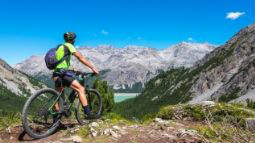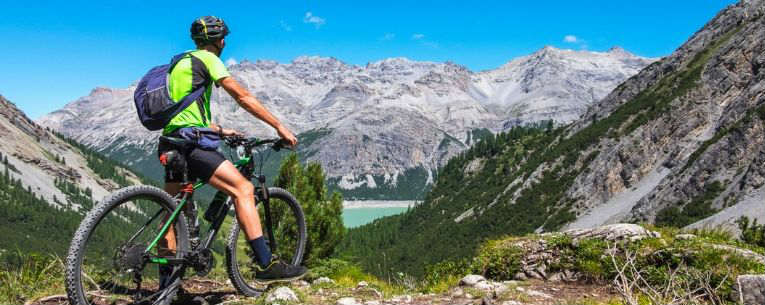Bike touring is perhaps the most accessible way to explore a destination — or at least a close second behind “walking around and looking at things.”
But with a little preparation, research and a bit of investment in the right gear, you can elevate bike touring from form a one-time experience to a travel lifestyle.
Below we’ll detail the essential equipment you need to hit the road or the trail. And if you’re ready to plan your first bike touring trip, we have another article dedicated to all the other preparation you’ll need to make your first bike tour your best trip ever.
Choosing Your Bike
The first piece of equipment you’ll need to ponder is pretty obvious: the bike, your best friend and fellow road warrior that will share an action-packed itinerary comprising days, weeks, or even months. (Some bike tours last years – seriously.)
And the first step to choosing a bike is determining if you’ll be buying or renting. Each comes with a long list of pros and cons. Let’s take a closer look…
- Renting a bike
This option makes the most sense for your maiden bike tour. Part of this has to do with simplicity: by renting you don’t need to transport your bike halfway around the globe, find the right shop to make all the proper adjustments, make needed repairs along the way, and then ship it home. No, tour rentals make it much easier. If you’re taking a group tour, they’re often included in the price of a guided tour. Otherwise, bike rentals can begin around $50/day, but so much depends on where you are and a host of other factors. Shop around if you’re in a travel hub and have a choice of rental provider.
- Buying a bike
Remember your very first bike? It may have shown up under the Christmas tree or been the culmination of hard work behind a lemonade stand or on a paper route. Buying a touring bike is going to be a vastly different experience. First let’s talk about budget; an “economical” bike is one you can find for less than $1,000. (Don’t get us wrong, part of the joy of bike touring is that there is no one right way to approach it. If you’re comfortable with the $100 bike you found on Craigslist and it works for you, have at it!) But buying a bike for bike touring trips also comes with recurring costs: transportation, which means repeated oversized luggage fees from an airline (and making sure it survives the journey is a great reason to find the right travel insurance plan for bike touring getaways).1
One last thing: As you take on your first bike tour and look to your next, it’s important to try out as many types of bikes as possible to see what’s most comfortable for you. Maybe it’s a road bike, which is designed to encourage riders to aerodynamically tuck their bodies when cruising down the road. A city, mountain or general purpose bike makes for a more upright ride — probably what you’re accustomed to experiencing aboard your old beach cruiser. It also matters where these bikes are built. If it’s called a touring bike in America (and the U.K.), it may be a hybrid of these two styles. During your first bike touring trip, you’ll want to do some hands-on homework to determine the best bicycle purchase for you if this is going to be more than a one-time experience.2 This is yet another reason to rent before you buy — you can treat each rental like a test ride.
Other Bike Touring Essentials
As you might assume, your touring bike might be the most important piece of the experience, but it’s also just the beginning of the list. That brings us to your packs. In most bike touring scenarios, you’re taking everything you need with you right on the bike. That’s kind of the point — otherwise it would just be a bike ride.
There are different approaches to packing your ride, but with all of these it’s imperative to pack light and to assume you can safely and comfortably pilot your bike with all this extra stuff.
- Backpacks: A budget-friendly, no-frills way to cart your stuff around. A backpack may do the trick for shorter rides, in total duration or how many miles you plan to take on each day. But the longer the trek, the less sensible the solution becomes. This is in part because you’re limited in storage capacity, and in part because it’s not the most comfortable option. Remember how your shoulders and back ached after a long day of carting an overstuffed backpack around campus? Now imagine doing the same, all day potentially over steep and challenging terrain.
- Panniers: A what? A pannier. Imagine you had multiple, more compact “backpacks” that fit in snugly and securely in the rear and front of your bike — typically, two each in the front and back. It’s a safer, smarter way to cart your stuff around for the long haul. Make sure they’re waterproof.
- Trailers: Maybe you have a lot of stuff. Or you simply prefer not to have your ride encumbered by so many bags (it can be a balancing act). Some bikers prefer to drag a slim, two-wheeled trailer behind them to free themselves of all the clutter.3
Now that you have an idea of where you’ll store your stuff, here’s a look at some other bike touring essentials to consider packing. This is by no means an exhaustive list; be sure to cater your packing list to your unique experience.
- Camping gear: If you plan on making the road your home, you’ll need a solid free-standing tent, sleeping bag designed for the local weather, as well as a stove and any other amenities you require to ensure your down time provides all the comfort and convenience you desire. Of course, remember that you’ll be carrying all this with you, so choose wisely.4
If you’ll be seeking out safe roadside or trailside camping spots, follow the rules of the road. Always ask permission before calling it a night on someone’s property and always pick up after yourself. You’ll want to make friends on your first trip, and you never know what doors can opened by following bike touring etiquette.5
- Bike helmet: Wearing a helmet is always a smart idea, even in countries where it’s optional and not very common, such as the Netherlands. Even if you’re renting a bike, you should have your own helmet, finding one that’s not only the right size, but also offers solid ventilation and accommodates any accessories you’d like to add (such as a mirror).6
- Food & drink: It’s about more than meals. Don’t forget the uber-important snacks to refuel your body throughout the ride.
- First Aid kit: Think about combating blisters, mosquitos and sunburn.
- Wayfaring gear: When deciding between old-school maps and high-tech GPS units, think about how remote your location will be — not just for charging access, but for signal strength, too.
- Clothing: Place a special emphasis on weather-appropriate, reflective / brightly colored, and moisture-wicking attire.
- Travel insurance: Whether you experience a trip delay en route to the bike tour, or simply get lost along the way, the right travel insurance plan is a smart move when setting off by bike on a multi-day journey.
Bike touring is as easy as hopping on your ride and pedaling away. But researching and procuring the right gear for your travel sensibilities and itinerary can elevate your two-wheeled excursion from just another trip to an all-time getaway — one you’re already planning on repeating.
Related Articles








Share this Page